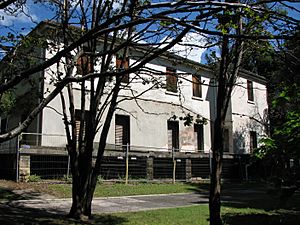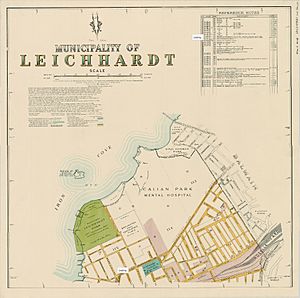Broughton Hall, Lilyfield facts for kids
Quick facts for kids Rozelle Hospital – Broughton Hall |
|
|---|---|

Broughton Hall, Callan Park, in 2020 – facing the garden area
|
|
| Location | Balmain Road, Lilyfield, Inner West Council, New South Wales, Australia |
| Built | c. 1841 |
| Architect | Charles Moore (plantings) |
| Owner | NSW Department of Health |
| Official name: Rozelle Hospital – Broughton Hall; Broughton Hall; Rivandall | |
| Type | state heritage (complex / group) |
| Designated | 2 April 1999 |
| Reference no. | 831 |
| Type | Psychiatric hospital/Mental institute/Asylum |
| Category | Health Services |
| Lua error in Module:Location_map at line 420: attempt to index field 'wikibase' (a nil value). | |
Broughton Hall is a historic house in Sydney, Australia, that has been a private home, a hospital for soldiers, and a clinic for mental health. It is located in an area called Callan Park in the suburb of Lilyfield. The house was built around 1841 and is now listed on the New South Wales State Heritage Register, which means it is protected as an important part of history.
Over the years, many other buildings were built around the main house. During World War I, it was used as a hospital for soldiers. Later, from 1921 to 1976, it was known as the Broughton Hall Psychiatric Clinic, a special hospital that helped people with their mental well-being.
In 1976, it joined with the nearby Callan Park Hospital for the Insane to become the Rozelle Hospital. After many years, the original Broughton Hall building was no longer used and was damaged by fire and vandalism.
Contents
History of Broughton Hall
Early History and First Peoples
Before Europeans arrived, the land where Broughton Hall stands was home to the Wangal clan. They were part of the Eora people. Their territory stretched along the Parramatta River. After European settlement began, diseases and land development greatly reduced the number of Aboriginal people living in the area.
In the early 1800s, the Australian government gave large pieces of land, called land grants, to European settlers. The land that would become Callan Park and the Broughton Hall estate was originally made up of several of these grants.
A Grand Private Home
A man named John Ryan Brenan owned a large estate called Garry Owen. Around 1841, he built a new house nearby, which he called Broughton House. He sold it in 1845. An advertisement from 1842 described it as a large house with four sitting rooms, six bedrooms, a kitchen, a wine cellar, and stables. It had beautiful views of the Parramatta and Lane Cove rivers.
For many years, Broughton House was a family home for wealthy and important people. From 1864 to 1905, it was owned by a businessman named John Keep. He changed the name to Broughton Hall and bought more land around it.
While other large estates in the area were broken up into smaller lots for new houses, Broughton Hall and its neighbour, Callan Park, remained as large properties.
A Hospital for Soldiers
During World War I (1914–1918), the owners of Broughton Hall offered it to the government to be used as a hospital. It became No. 13 Australian Army Hospital. The house and its beautiful gardens were a peaceful place for soldiers returning from the war to recover from the stress of battle.
This was an important time for mental health care. Broughton Hall provided a new way of helping people, and it later became a key part of the Callan Park hospital complex.
The Broughton Hall Psychiatric Clinic
After the war, the government officially took over the property. On April 4, 1921, it opened as the Broughton Hall Psychiatric Clinic. This was the first clinic of its kind in New South Wales where people could choose to be admitted for help with mental health issues.
Dr. Sydney Evan Jones, who was in charge for many years, believed that beautiful gardens could help patients feel better. He redesigned the gardens in the 1920s to create a calming and therapeutic environment. Paths, ponds, and bridges were built, and the gardens became an important part of the treatment.
Between 1920 and 1935, new buildings were added that matched the style of the original house.
Becoming Part of Rozelle Hospital
In 1976, Broughton Hall and the nearby Callan Park Mental Asylum were combined to create one large hospital called Rozelle Hospital. The original Broughton Hall building was used by a youth service called the Rivendell Child, Adolescent and Family Unit for a short time.
After the Rivendell Unit moved out in 1977, the old house was left empty. It fell into disrepair and was badly damaged by a fire in 1986. Even as other parts of Rozelle Hospital were being upgraded, the original Broughton Hall building remained abandoned. Rozelle Hospital eventually closed in 2008.
Broughton Hall Today
For many years, the original Broughton Hall building has been vacant and in very poor condition. Its windows are boarded up, and it has suffered from neglect and vandalism. Groups like the Friends of Callan Park have raised concerns about protecting the historic house and its gardens.
Although the main house is empty, some of the other buildings on the site are still in use. The University of Tasmania has a campus there, and other buildings are used for health services.
Description of the Site
The original Broughton Hall is a two-story house built in a style called Victorian Georgian Revival. The walls are painted, and the old slate roof has been replaced with concrete tiles. Although the house is now just a shell, it still stands on its original land.
The grounds are a special feature of the property. They include a rainforest gully with a creek that runs down to the Parramatta River. The gardens have plants from the late 1800s and 1900s, including some rare trees. Some of these were recommended by Charles Moore, who was once the director of the Royal Botanic Garden in Sydney.
Why is Broughton Hall Important?
Broughton Hall is important for several reasons:
- It is one of the oldest houses left in the area and is connected to the early history of Rozelle.
- The house is an impressive example of early Victorian architecture.
- Its large gardens still have much of their original design, including special features and rare plants.
- The gardens are historically important because they show how Dr. Sydney Evan Jones used nature to help treat patients at the psychiatric clinic.
Because of its historical and cultural value, Broughton Hall was listed on the New South Wales State Heritage Register on April 2, 1999. This listing helps protect the site for the future.


